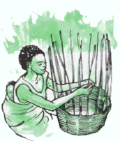



Making mats from forest products is an important source of income for many rural women in Asia. Small-scale forest industries provide part-time employment for hundreds of millions of people.
These small-scale enterprises are normally labour intensive and require only a very small capital outlay; members of even the poorest sectors of society are therefore able to run such enterprises. Outside farming, forest-based processing operations have been found to be one of the largest employers and one of the most widely available sources of income in rural areas (see box right).
Gathering and processing forest products may be a main source of income, or provide a supplementary income for people primarily involved in activities outside the forest, such as farming. The money earned in this way may be spent on food, or invested in agricultural assets such as livestock or seeds to secure future food supplies.
Forest products often act as a buffer during periods of food shortage. Some people regularly gather products such as fuelwood and rattan canes to store and sell when cash is needed for food. Others turn to selling forest products only in emergencies, when food or cash are scarce.
A number of income-generating activities are based on foods from the forest; the collection of forage, nuts, fruits, and fungi is common. Fishing is a profitable activity, and hunting for bushmeat can provide substantial financial rewards. The value of food products can be increased by processing, and the sale of palm wine and oils is widespread. Honey production is an important forest industry in many parts of the world; Indian villages are thought to produce more than 37 000 tonnes a year for sale.
Both men and women are involved in forest-based processing activities. Women tend to dominate in the production of items relating to the home and to agriculture. The gathering and processing of raw materials available near the home can be easily combined with, or fitted into, women's daily work routines. Men, because they have have fewer constraints on their time than women and better access to ray materials and markets, may produce a wider range of forest products including items that have a high market value. Though both men and women increase the household income through such activities, studies show that women are more likely to spend additional income on food for the family than are men.
Returns on these activities vary: carpentry and other skills that are in demand on the general market have the highest returns; and those catering to domestic needs, such as basketry and mat-making (usually carried out by women), bring lower returns. However, the advantage of such activities over employment by larger firms is that more of the profits accrue directly to the household involved.
The processing of forest products provides a significant percentage of the income of many millions of rural households, and contributes to the rural economy in many countries. However, it is the poorest sectors of society -the landless and small-scale farmers-that rely most heavily on income generated from forest products. For them, this income can be critical.
In many parts of the world, forest lands are under threat from several sides, leaving the poor even more vulnerable. Because of increasing population levels, less agricultural land is available and an ever-growing number of people are turning to forest products to supplement their income. Trees and other products are being removed from forests faster than they can grow back, leading to a diminishing source of raw materials.
At the same time, much forest land is being cleared for agriculture; access to remaining forests is increasingly restricted, and few gatherers can afford to pay to use private forest land. Thus, the poor are gradually losing both access to an important source of supplementary food and a major source of income.
One solution is to organize the communal management of forest lands. This can result in the sustainable use of forest resources, and thus brings benefits to the whole community, but particularly to its poorest members.

The production of handicrafts is an important industry in many developing countries: capital outlay is low and returns are high-hut finding suitable material becomes more difficult as forest reserves diminish.
Small-scale farmers in many parts of the world have traditionally combined food production with tree cultivation to provide cash crops such as rattan, fuelwood and coconuts. Farmers in some regions are now finding food production uneconomic and are transferring some or all of their land to the cultivation of trees as cash crops.
In Java, for instance, rising populations have led to a reduction in farm size and many farmers can no longer grow enough food to support themselves. As a result, many farmers are turning to off-farm employment and to the production of trees as cash crops. Under the right conditions, tree production can provide higher returns in relation to labour input than food production. This allows farmers to take jobs off the farm, and buy the food that they can no longer grow on their own lands.
In many areas of Kenya, where soil degradation is common on small farms, yields are falling as a result of drought and crop failure. In these circumstances trees, which are a lower-risk crop than food, are grown for cash by farmers whose land can no longer produce food crops economically. Two species are particularly favoured: eucalyptus, for poles, and black wattle, for poles, fuelwood, charcoal and house construction. Woodlots are grown on very small farms, some no larger than half a hectare, and about a quarter of their area is devoted to the tree crop.
In countries such as the Philippines where, in some areas, labour rather than land is in short supply and hence expensive, land that was previously used for food crops is being given over to the less labour-intensive cultivation of trees as cash crops. Farmers thus obtain income from land which the high price of labour has made an uneconomic for farming. Farm woodlots have proved popular over much of the Philippines, with farmers selling Albizia falcateria (batai) to a local pulp company. Excluding land costs, returns have been estimated at 22-32 percent per annum.

Farm trees grown as cash crops can provide rural women with brushwood for both cooking and for selling in the market. Either way, food security is increased.
In Haiti more than 200 000 farmers have begun to grow trees as cash crops-initially for fuelwood and charcoal only. Multi-purpose trees are now being increasingly grown, and trees are intercropped with maize, sorghum and beans. Agroforestry of this kind is less of a risk than the cultivation of a single cash crop.
Tree cultivation is not restricted to richer farmers; it is also attractive to poorer farmers since it often requires less initial capital than food production. Gross returns are generally less than from food crops but risks are lower, and labour and capital requirements are smaller. Moreover, planting trees is a way of maintaining productivity where the alternatives, such as buying fertilizer and herbicides, are too expensive.
Trees are often grown as an insurance policy against hard times and as an investment for the future. Trees can be harvested to meet emergency needs for cash, or to finance the purchase of equipment or land. A survey in Bengal shows that typically about 40 percent of the income from tree crops is used to buy land.
It is not only farm land that is under pressure; forests are also increasingly under pressure from growing populations and commercial interests, and many local people no longer have access to forest lands and products. One response to this problem is to grow trees as cash crops on farms, often to replace income previously obtained from the forest and its products. Studies in Nepal show a direct relation between the reduction in forest reserves and the farm area devoted to trees grown as cash crops on farms.
In many countries, the income from tree cultivation has traditionally contributed to food security, because the money earned is spent on food, additional agricultural land, equipment and inputs. Where food production, for consumption or sale, is no longer economically viable, however, the cultivation of trees as cash crops has become essential for survival.